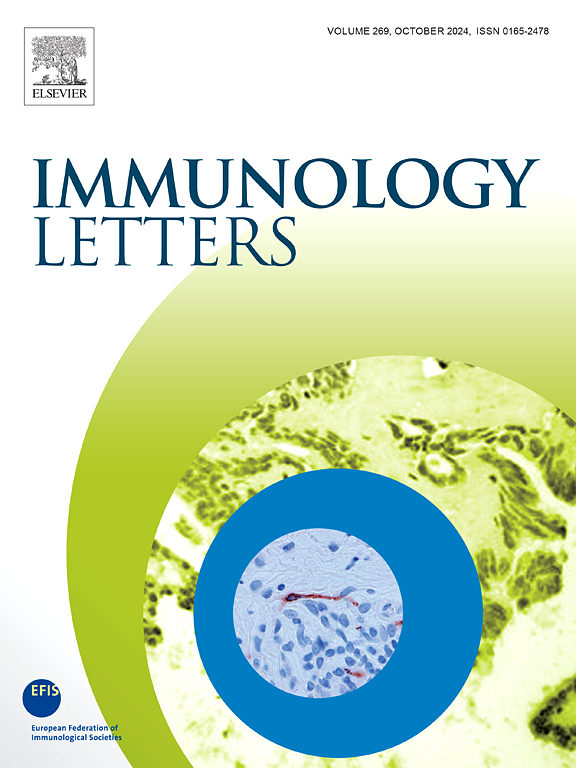抑制谷氨酰胺酶1可减少M1巨噬细胞极化,以保护免受单芥碱诱导的肺动脉高压。
IF 2.8
4区 医学
Q3 IMMUNOLOGY
引用次数: 0
摘要
(1)背景:代谢异常和免疫炎症是肺动脉高压(PAH)发病的关键因素。在PAH患者中观察到异常的谷氨酰胺代谢;然而,谷氨酰胺酶1 (GLS1)在巨噬细胞中的功能尚不清楚。因此,我们旨在研究GLS1对PAH中巨噬细胞的影响。(2)方法:首先构建MCT诱导的PAH大鼠模型。简单地说,用GLS1抑制剂BPTES治疗PAH大鼠,并评估各种指标,包括血流动力学、右心室功能、肺血管重构、巨噬细胞标志物和谷氨酰胺代谢。之后,我们将骨髓源性巨噬细胞(bmdm)极化为M1表型,然后进行BPTES干预。最后,我们评估了巨噬细胞表型、炎症标志物和谷氨酰胺代谢指标,以及BMDM上清对肺动脉平滑肌细胞(PASMCs)行为的影响。(3)结果:GLS1在PAH患者和大鼠中均显著上调。GLS1抑制剂BPTES治疗可显著改善PAH大鼠肺动脉压、右心室功能和肺血管重构,同时抑制M1巨噬细胞极化、NLRP3激活和促炎细胞因子的释放。这反过来又减轻了炎症刺激诱导的PASMCs的增殖和迁移。(4)结论:我们认为靶向GLS1减少M1巨噬细胞极化和炎症反应可能是治疗PAH的一种有希望的方法。本文章由计算机程序翻译,如有差异,请以英文原文为准。
Inhibition of glutaminase 1 reduces M1 macrophage polarization to protect against monocrotaline-induced pulmonary arterial hypertension
(1)
Background
Metabolic abnormalities and immune inflammation are key elements within pathogenesis of pulmonary arterial hypertension (PAH). And in PAH patients, aberrant glutamine metabolism has been observed; however, the function of glutaminase 1 (GLS1) in macrophage is still unknown. So we aims to investigate GLS1′s impact upon macrophages in PAH. (2)
Methods
We firstly constructed an monocrotaline (MCT)-induced PAH rat model. Briefly, the PAH rats were treated with the GLS1 inhibitor BPTES, and various index were evaluated, including hemodynamics, right ventricular function, pulmonary vascular remodeling, macrophage markers, and glutamine metabolism. After that, we polarized bone marrow-derived macrophages (BMDMs) into M1 phenotype and then subjected to BPTES intervention. Finally, we assessed macrophage phenotype, inflammatory markers, and glutamine metabolism indicators, along with the impact of BMDM supernatant on the behavior of pulmonary arterial smooth muscle cells (PASMCs). (3)
Results
GLS1 was significantly upregulated in both PAH patients and rats. Treatment with the GLS1 inhibitor BPTES markedly improved pulmonary arterial pressure, right ventricular function, and pulmonary vascular remodeling in PAH rats, while inhibiting M1 macrophage polarization, NLRP3 activation, and the release of pro-inflammatory cytokines. This, in turn, alleviated the proliferation and migration of PASMCs induced by inflammatory stimuli. (4)
Conclusion
We propose that targeting GLS1 to reduce M1 macrophage polarization and inflammatory responses may represent a promising therapeutic approach for PAH.
求助全文
通过发布文献求助,成功后即可免费获取论文全文。
去求助
来源期刊

Immunology letters
医学-免疫学
CiteScore
7.60
自引率
0.00%
发文量
86
审稿时长
44 days
期刊介绍:
Immunology Letters provides a vehicle for the speedy publication of experimental papers, (mini)Reviews and Letters to the Editor addressing all aspects of molecular and cellular immunology. The essential criteria for publication will be clarity, experimental soundness and novelty. Results contradictory to current accepted thinking or ideas divergent from actual dogmas will be considered for publication provided that they are based on solid experimental findings.
Preference will be given to papers of immediate importance to other investigators, either by their experimental data, new ideas or new methodology. Scientific correspondence to the Editor-in-Chief related to the published papers may also be accepted provided that they are short and scientifically relevant to the papers mentioned, in order to provide a continuing forum for discussion.
 求助内容:
求助内容: 应助结果提醒方式:
应助结果提醒方式:


